
Hi, I'm Mia! Let's discover how documentation is kept and used in a regulated manufacturing environment.
- Subject:
- Allied health personnel
- CTE
- Material Type:
- Unit of Study
- Date Added:
- 09/11/2018

Hi, I'm Mia! Let's discover how documentation is kept and used in a regulated manufacturing environment.

If you know a bit about using a mouse and keyboard but don't know your way around using a computer just yet, this is the class for you. Learn how to use a Mac (Apple) with the OS X Operating System.

If you know a bit about using a mouse and keyboard but don't know your way around using a computer just yet, this is the class for you. Learn how to use a PC (Personal Computer) with the Windows 7 Operating System.

What are the differences between graduated cylinders, beakers, and Erlenmeyer flasks? Practice measuring volumes and determine percent error and standard deviation for each piece of lab glassware.
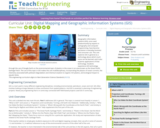
Geographic information systems (GIS), once used predominantly by experts in cartography and computer programming, have become pervasive in everyday business and consumer use. This unit explores GIS in general as a technology about which much more can be learned, and it also explores applications of that technology. Students experience GIS technology through the use of Google Earth on the environmental topic of plastics in the ocean in an area known as the Great Pacific Garbage Patch. The use of this topic in GIS makes the unit multidisciplinary, incorporating the physics of ocean currents, the chemistry associated with pollutant degradation and chemical sorption to organic-rich plastics, and ecological impact to aquatic biota.

Learn the basics of Skype in this class, including signing up, adding contacts, and making a video call.

Learn what cloud storage is, who offers it, and how to use it in this class.

Students are introduced to genetic techniques such as DNA electrophoresis and imaging technologies used for molecular and DNA structure visualization. In the field of molecular biology and genetics, biomedical engineering plays an increasing role in the development of new medical treatments and discoveries. Engineering applications of nanotechnology such as lab-on-a-chip and deoxyribonucleic acid (DNA) microarrays are used to study the human genome and decode the complex interactions involved in genetic processes.
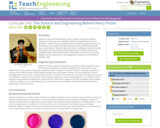
Under the "The Science Behind Harry Potter" theme, a succession of diverse complex scientific topics are presented to students through direct immersive interaction. Student interest is piqued by the incorporation of popular culture into the classroom via a series of interactive, hands-on Harry Potter/movie-themed lessons and activities. They learn about the basics of acid/base chemistry (invisible ink), genetics and trait prediction (parseltongue trait in families), and force and projectile motion (motion of the thrown remembrall). In each lesson and activity, students are also made aware of the engineering connections to these fields of scientific study.
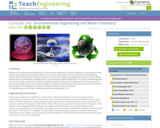
Students are introduced to the fundamentals of environmental engineering as well as the global air, land and water quality concerns facing today's environmental engineers. After a lesson and activity to introduce environmental engineering, students learn more about water chemistry aspects of environmental engineering. Specifically, they focus on groundwater contamination and remediation, including sources of contamination, adverse health effects of contaminated drinking water, and current and new remediation techniques. Several lab activities provide hands-on experiences with topics relevant to environmental engineering concerns and technologies, including removal efficiencies of activated carbon in water filtration, measuring pH, chromatography as a physical separation method, density and miscibility.

Environmental Monitoring is a challenging and serious game which places you in a virtual cleanroom, tasked with performing typical personnel, surface, non-viable, and viable particle counting activities.

Learn the basics of Skype in this class, including signing up, adding contacts, and making a video call.
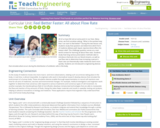
All of us have felt sick at some point in our lives. Many times, we find ourselves asking, "What is the quickest way that I can start to feel better?" During this two-lesson unit, students study that question and determine which form of medicine delivery (pill, liquid, injection/shot) offers the fastest relief. This challenge question serves as a real-world context for learning all about flow rates. Students study how long various prescription methods take to introduce chemicals into our blood streams, as well as use flow rate to determine how increasing a person's heart rate can theoretically make medicines work more quickly. Students are introduced to engineering devices that simulate what occurs during the distribution of antibiotic cells in the body.

Grow and harvest E. coli through a virtual lab-scale fermentation process.

If you know a bit about using a mouse and keyboard but don't know your way around using a computer just yet, this is the class for you. Learn how to use a Mac (Apple) with the OS X Operating System.
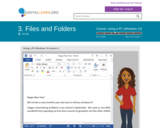
If you know a bit about using a mouse and keyboard but don't know your way around using a computer just yet, this is the class for you. Learn how to use a PC (Personal Computer) with the Windows 10 Operating System.

If you know a bit about using a mouse and keyboard but don't know your way around using a computer just yet, this is the class for you. Learn how to use a PC (Personal Computer) with the Windows 7 Operating System.

Construct gravity and vacuum filtration units to filter sand from water.

Learn to navigate your way around websites.

Students are introduced to the important concept of density with a focus is on the more easily understood densities of solids. Students use different methods to determine the densities of solid objects, including water displacement to determine volumes of irregularly-shaped objects. By comparing densities of various solids to the density of water, and by considering the behavior of different solids when placed in water, students conclude that ordinarily, objects with densities greater than water sink, while those with densities less than water float. Then they explore the principle of buoyancy, and through further experimentation arrive at Archimedes' principle that a floating object displaces a mass of water equal to its own mass. Students may be surprised to discover that a floating object displaces more water than a sinking object of the same volume.